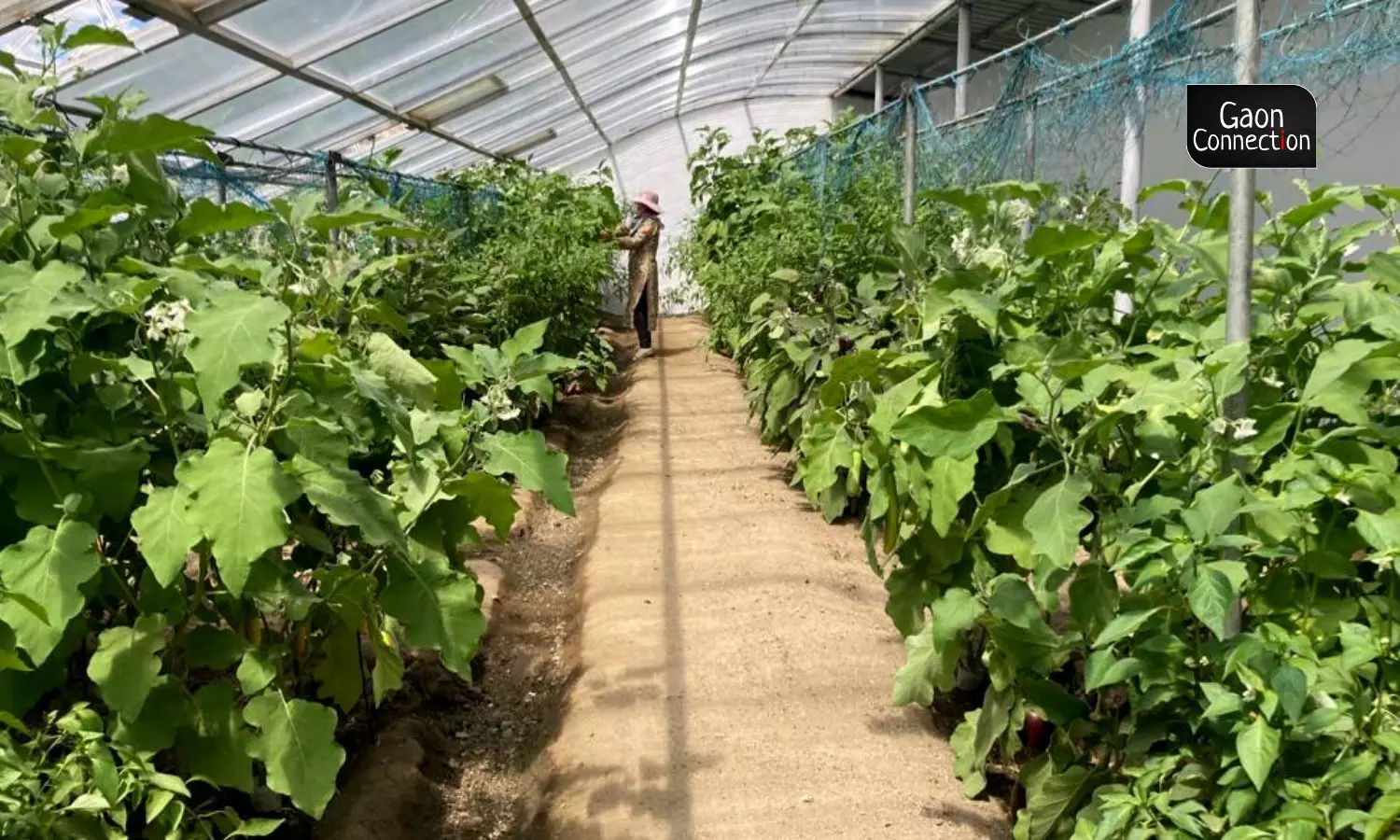Cabbage, cauliflower, tomatoes and spinach — Ladakhi farmers grow vegetables in sub-zero temperatures
Over 800 farmers in Ladakh have set up solar greenhouses developed by the Defense Institute of High Altitude Research, which help them grow a variety of vegetables in the icy climes of the Union Territory. Their families eat better and the farmers earn good profits in the winter season.
 Mudassir Kuloo 26 Dec 2022 7:56 AM GMT
Mudassir Kuloo 26 Dec 2022 7:56 AM GMT

In the last two years over 800 farmers have installed solar power houses in the Union Territory of Ladakh giving them access to fresh vegetables even in the bitterest cold between November and February. (All photos: Dr Tsering Stobdan, Senior Scientist, DIHAR)
Winter months were always a struggle for Rincha Angchuk, a 50-year-old farmer of Khalsi village in Ladakh. Besides the biting cold, finding nutritious vegetables to feed his wife and two daughters was always a challenge.
"Tomatoes in the winter months could cost as much as Rs 150 to Rs 200 a kilogram, and because the vegetables are airlifted from Delhi or Srinagar into showbound Ladakh, the prices are high and most of us cannot afford it," Angchuk told Gaon Connection.
Angchuk would usually sit idle in the winter months as the climate did not allow him to practise any kind of agriculture. But things changed when Angchuk learnt about Ladakh Greenhouse, a passive solar greenhouse, which allows farmers to grow a variety of vegetables throughout the winter season.
The cropping season in Ladakh is severely restricted due to its icy winters, when the temperature dips to minus 20-30 degree Celsius.
"I approached the government's agriculture department in July 2021, and with its help installed an 18 x 32 feet solar greenhouse, in which I can grow vegetables even in the midst of freezing temperatures," Angchuk said.
The cropping season in Ladakh is severely restricted due to its icy winters, when the temperature dips to minus 20-30 degree Celsius. But, the 50-year-old Ladakhi farmer has cultivated cabbage, spinach, cauliflower and coriander, all between November 2021 and April 2022.
"My family has eaten better and I have earned Rs 40,000 selling the vegetables in these months," he said.
Also Read: Ladakh to go fully organic by 2025
The chief agriculture officer of Ladakh, Shakeel Ahmad, informed Gaon Connection that in the last two years over 800 farmers have installed solar power houses in the Union Territory of Ladakh. Even in the bitterest cold between November and February, the farmers now have fresh vegetables to eat and sell, he said.
"We are receiving an immense response from the farmers. The department bears the cost of polycarbonate sheets, doors, and windows. And, the government is installing these solar power houses at a subsidy of 70 per cent," Shakeel Ahmad said. By the end of next year, we have set up a target of installing 1,000 more solar greenhouses, he added.
According to him, these solar greenhouses help the local communities get fresh vegetables through the year and reduce the expenditure they now face buying vegetables coming in from other places.
Developing a solar greenhouse for Ladakh
Scientists at the Defense Institute of High Altitude Research (DIHAR) began work on a solar greenhouse in 2014, hoping to develop a version that would be more efficient than the traditional ones that froze up in the winters. DIHAR is a defence laboratory of the Defence Research and Development Organisation (DRDO) located in Leh city of Ladakh.
"After several years, we managed to develop solar greenhouses. The maximum temperature recorded in these is above 40 degree Celcius in the summers and the lowest temperature recorded in peak winter months amid extreme cold conditions is 5-10 degrees Celsius. This is enough to grow vegetables in winter months," Tsering Stobdan, the lead scientist in the initiative, told Gaon Connection.
The cropping season in Ladakh is severely restricted but between November 2021 and April 2022, farmers here have cultivated cabbage, spinach, cauliflower and coriander.
He further explained how while regular greenhouses became untenable when the temperature dropped below zero outside, solar greenhouses did not need to be heated, but they retained the heat derived from the sunlight during daylight hours and kept warm.
Once DIHAR developed the greenhouse, in 2018, it transferred the technology to the agriculture department of Ladakh. Now the Agriculture Department Ladakh is providing these solar greenhouses to farmers at subsidised rates.
While regular polyhouses cost up to Rs 50,000, a solar power house of 18 x 32 feet costs Rs 2.5 lakh, and a 60 x 24 feet solar power house costs Rs 4 lakh, chief agriculture officer Ahmad said.
The polycarbonate sheets used in the greenhouses maintain a temperature of around 10 degrees Celsius even during freezing outside temperature, he added. The sheets allowed light transmission, provided thermal insulation and were resistant to weathering.
The DIHAR passive solar greenhouse does not need to be heated. It keeps the heat in it that is gained during the day through sunlight.
"Farmers who can't find work during the winter season can now grow their earnings thanks to the greenhouse. This has also reduced the dependence on vegetables coming from outside Ladakh," Ahmad pointed out.
The agriculture department also provides training to farmers about how and what they can grow in the greenhouses during the winters. These are individual solar greenhouses, he added.
Better nutrition and income for Ladakhi families
"Last winter, I grew tomatoes, cauliflower and okra and earned almost Rs 40,000 by selling vegetables grown in my solar greenhouse," 45-year-old farmer Tunduk Kunzung of Thekse village in Leh district told Gaon Connection. He installed the greenhouse two years ago, he said.
"If we have to think long term and make Ladakh self-reliant then every farmer should adopt these greenhouses," Kunzung strongly advised. He was one of the earliest to set up the structure.
#Ladakh agricuture farmers #story
More Stories




